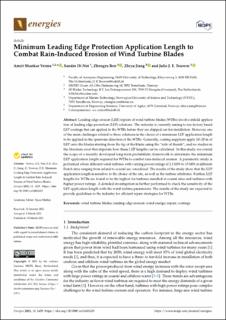| dc.contributor.author | Verma, Amrit Shankar | |
| dc.contributor.author | Di Noi, Sandro | |
| dc.contributor.author | Ren, Zhengru | |
| dc.contributor.author | Jiang, Zhiyu | |
| dc.contributor.author | Teuwen, Julie J. E. | |
| dc.date.accessioned | 2021-10-27T11:42:14Z | |
| dc.date.available | 2021-10-27T11:42:14Z | |
| dc.date.created | 2021-07-14T16:32:44Z | |
| dc.date.issued | 2021 | |
| dc.identifier.citation | Energies. 2021, 14 (6), 1-26. | en_US |
| dc.identifier.issn | 1996-1073 | |
| dc.identifier.uri | https://hdl.handle.net/11250/2826003 | |
| dc.description.abstract | Leading edge erosion (LEE) repairs of wind turbine blades (WTBs) involve infield application of leading edge protection (LEP) solutions. The industry is currently aiming to use factory based LEP coatings that can applied to the WTBs before they are shipped out for installation. However, one of the main challenges related to these solutions is the choice of a minimum LEP application length to be applied in the spanwise direction of the WTBs. Generally, coating suppliers apply 10–20 m of LEP onto the blades starting from the tip of the blade using the “rule of thumb”, and no studies in the literature exist that stipulate how these LEP lengths can be calculated. In this study, we extend the scope of a recently developed long-term probabilistic framework to determine the minimum LEP application length required for WTBs to combat rain-induced erosion. A parametric study is performed where different wind turbines with varying power ratings of 2.1 MW to 15 MW at different Dutch sites ranging from inland to coastal are considered. The results of the study show that the LEP application length is sensitive to the choice of the site, as well as the turbine attributes. Further, LEP lengths for WTBs are found to be the highest for turbines installed at coastal sites and turbines with higher power ratings. A detailed investigation is further performed to check the sensitivity of the LEP application length with the wind turbine parameters. The results of the study are expected to provide guidelines to the industry for efficient repair strategies for WTBs | en_US |
| dc.language.iso | eng | en_US |
| dc.publisher | MDPI | en_US |
| dc.rights | Navngivelse 4.0 Internasjonal | * |
| dc.rights.uri | http://creativecommons.org/licenses/by/4.0/deed.no | * |
| dc.title | Minimum leading edge protection application length to combat rain-induced erosion of wind turbine blades | en_US |
| dc.type | Peer reviewed | en_US |
| dc.type | Journal article | en_US |
| dc.description.version | publishedVersion | en_US |
| dc.source.pagenumber | 1-26 | en_US |
| dc.source.volume | 14 | en_US |
| dc.source.journal | Energies | en_US |
| dc.source.issue | 6 | en_US |
| dc.identifier.doi | 10.3390/en14061629 | |
| dc.identifier.cristin | 1921775 | |
| cristin.ispublished | true | |
| cristin.fulltext | original | |
| cristin.qualitycode | 1 | |

